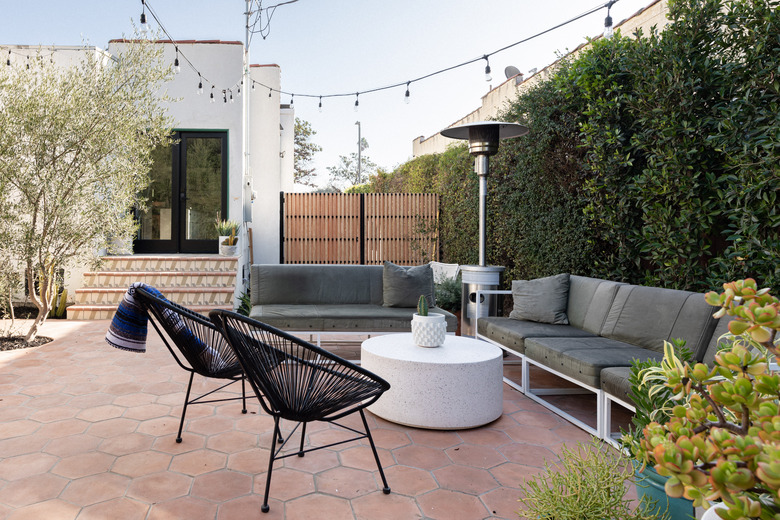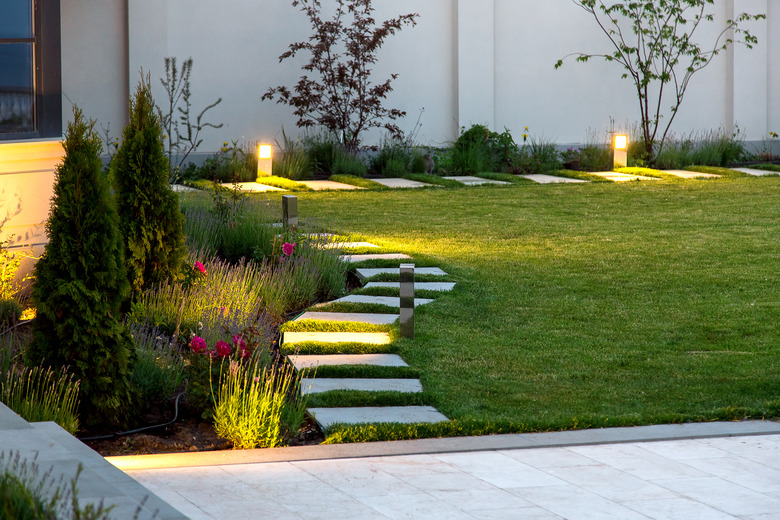Types Of Landscape Lighting
Landscape lighting can do a lot of things for your yard. Good landscape lighting design doesn't just make your yard safer to navigate in the dark, though that is an important goal. It also highlights focal points, such as a large tree or stunning floral beds, and adds a new atmosphere to a garden area that it doesn't possess during the day, such as highlighting the texture of a stone wall.
The best outdoor lighting plan will do all three of these. For example, lighting a massive cactus can help visitors avoid its spines, can bring attention to the impressive piece of flora and can dramatically emphasize the shadows cast by the spines. To design an effective exterior lighting system, you'll need to have a thorough understanding of the different types of lights available for landscaping.
Types of Landscape Lighting
You first need to know the specific types of light fixtures available when considering the right exterior lighting for your home. Only then can you start to consider how each of these lighting ideas may contribute to your overall outdoor space. Some of the most popular options include:
-
Garden lights: Also
called pathway or walkway lights, these classic outdoor lighting fixtures feature a canopy set on a post that is usually anywhere from 6 to 24 inches long.
Garden lights are best used for path lighting or in planting beds, as the light
reflects down around the base. These fixtures should be placed prominently, and they come in a wide variety of styles and finishes to
enhance the curb appeal of your yard both night and day. -
Bollard lights: These
lights consist of posts with lights built into the top but without the canopies
of garden lights. These are one of the
only landscape lighting fixtures that sends light in all directions, which makes
them useful for a wide variety of purposes, including walkways, buildings and
landscaping. They work particularly well as path lights by providing guideposts
around a walkway. Like garden lights, there are many attractive styles of
bollard lights. -
Step lights, deck lights and hardscape lights: While each of
these light sources is slightly different, they all involve a very small light fixture designed to attach to a structure. Step lights sit under a step riser to the side of the tread
or in the center of the tread and are most commonly used to make stairs safer to
use at night. Deck lights attach anywhere on a deck railing and can make it
easier to use the deck at night or to highlight an architectural detail. Hardscape
lights are designed to be secured onto a brick wall, a boulder, a fence post or any other permanent hardscape feature. -
String lights: Not
just for Christmas trees, string lights look brilliant when strung across a
deck, through trees or on top of hardscapes. The repeating, gentle light
sources are both subtle and warm. For a classy touch, look for eye-catching Edison bulbs. -
Well lights: These
are best distinguished by the fact that they are mounted below ground inside a waterproof
housing. This means they are only used to light up details such as architectural
features, trees, large shrubs, etc. Some well lights can be installed
under water, offering an attractive way to light up water features at night.
Different Types of Spotlights
A particularly useful light source for landscape purposes is a spotlight, which projects light in only one direction. There are many different types of spotlights available, ranging from subtle, narrow designs to dazzlingly bright designs that light up whole walls. Spotlights are generally used for uplighting or downlighting, meaning they are set low to the ground or high in the air to create a dramatic lighting effect with long shadows.
-
Floodlights: These
are particularly bright, high-wattage lights that have a beam width that shines
anywhere from 40 to 120 degrees wide. Most people are familiar with the
motion-sensor floodlights often installed above a garage or front walkway, but floodlights
can be used for a wide variety of purposes. That being said, they should be
used sparingly because they are so bright and large, and they are best reserved for
large trees, driveways or patios or to highlight architectural details on the
home itself, such as an elaborate entryway. -
Wash lights: These
are another type of spotlight, but unlike floodlights, the light they project
is diffused, making it appear much softer. Wash lights are mostly used to bring
even illumination along wide surfaces, such as fences, facades and garden
walls. This soft, wide-angled effect is known as "washing." -
Bullet: This
style of spotlight is housed in a compact fixture that shoots a particularly narrow
beam. Bullet lights are best used for accent lighting to highlight specific details, such as
smaller trees, individual plants and garden structures like sculptures.
Common Lighting Effects
The dramatic effects created by washing with wash lights or uplighting and downlighting with spotlights are far from the only common effects used in your landscape lighting. You can also try these techniques when planning a lighting design:
-
Moonlighting:
Downlighting that looks natural, as though it is trickling gently down through
the trees. -
Silhouetting:
Placing a light behind an object to create a shadow outlined in light. The goal
of this effect is to highlight the object's shape, letting the light serve as
the main focal point. -
Shadowing:
Similar to silhouetting, this technique involves using a shadow to enhance the
design, only this method lights the object from the front, projecting its
shadow onto another object. A good example is lighting a tree or rose bush so its
shadow prominently projects onto a wall. -
Grazing: When a
light is placed particularly close to and almost parallel with an object,
highlighting the texture, this is known as "grazing." This can create a particularly
dramatic effect on stone and rough tree bark.
Different Types of Lighting Systems
There are two main types of lighting systems, and before shopping for fixtures or even planning your layout, you need to decide whether you want a hardwired system or a solar system. Popular Mechanics explains that a hardwired system uses a step-down transformer that reduces the 120-volt current from your house to a lower, safer 12 volts. This makes the systems safer to use and easier to install.
Most transformers include a programmable timer that allows the user to schedule the lights to go on or off automatically every day. A cable is then installed underground, and each fixture will connect to the cable using connectors that pierce through the cable, making contact with the wires inside.
By contrast, solar-powered lights need no cable because each light includes its own power source. This consists of a small solar panel that charges a battery during the day. The battery stores the electricity and uses it to power the light at night. Each fixture can go anywhere you like; you simply stake it into the ground.
While the installation is much simpler than with a hardwired system, it's important to follow the manufacturer's recommendations for each light's applications and spacing. You also need to look at your yard design and ensure that your lights will actually get sufficient sun exposure, which may mean cutting back some trees or hedges or changing your installation location.
For both hardwired and solar light systems, it's a good idea to use LED light bulbs rather than halogen bulbs. LEDs use about 90 percent less electricity than halogen bulbs, and they also last as much as 40 times longer than halogen. So, even though the LED bulbs may cost about three times as much initially, they will pay for themselves over and over as time goes on.
It's worth mentioning that some light systems, such as string lights, need to be plugged into a standard exterior wall outlet. Similarly, some motion-activated lights, usually pathway lights, are actually powered by batteries.
References
- Volt: Guide to Outdoor Downlighting: Nature Inspired Lighting from Above
- This Old House: All About Landscape Lighting
- Lumens: Landscape Lighting Guide
- Outdoor Lighting Perspectives: Landscape Lighting Techniques and Types
- TerraCast Products: 7 Types of Landscape Lighting Your Property Could Benefit From
- Hinkley: Landscape Lighting Techniques and Tips
- Premier Ponds & Lighting: Types Of Outdoor Landscape Lighting: 7 Must-Have Fixtures
- Vispronet: Halogen & LED Bulbs — What's The Difference?
- Volt: Common Landscape Lighting Fixtures
- Popular Mechanics: How to Put in Low-Voltage Landscape Lighting
- Black + Decker: How to Install Solar Landscape Lighting

